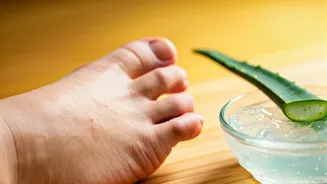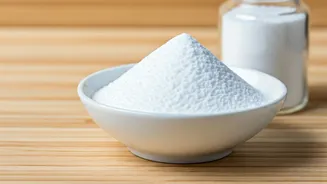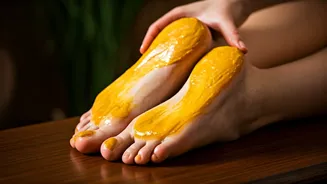Understanding Shoe Bites
Shoe bites, typically caused by friction from footwear, manifest as blisters or raw skin, often on the heels, ankles, or toes. Prevention involves wearing
properly fitted shoes and socks, but if you're already suffering, home remedies can provide significant relief. These remedies aim to reduce friction, prevent infection, and encourage healing. It's important to remember that if the shoe bite becomes severely infected, or if you have any underlying health conditions, seeking advice from a medical professional is recommended. Proper hygiene and careful observation are essential during the healing process to ensure the affected area recovers without complications. Addressing the issue early often leads to faster and more effective healing.
Aloe Vera's Soothing Power
Aloe vera, a natural anti-inflammatory, is an excellent choice for soothing skin irritations. Its gel, readily available from aloe vera plants or commercially, helps to reduce redness and pain associated with shoe bites. To use, simply apply a generous amount of aloe vera gel directly to the affected area. Allow it to absorb fully, which may take about 15-20 minutes. Repeat this several times a day. Aloe vera promotes faster healing and creates a protective barrier, reducing the risk of further irritation from shoes or clothing. The cooling effect of aloe vera also helps to alleviate the burning sensation, offering immediate comfort. For those with access to an aloe vera plant, the fresh gel is highly recommended due to its purity and potency, providing maximum benefits for skin regeneration.
The Healing of Honey
Honey is known for its antibacterial and wound-healing properties. Applying honey to shoe bites can help prevent infection and expedite the healing process. Its natural enzymes and antioxidants work to soothe the skin and promote tissue repair. Gently clean the affected area with mild soap and water before applying a thin layer of honey. Cover it with a clean bandage to protect it from further friction and contamination. Change the bandage and reapply honey twice a day. The stickiness of honey provides a moist environment that aids healing, while also creating a barrier against harmful bacteria. Opt for raw, unfiltered honey if possible, as it retains more of its beneficial compounds and offers the best results. Over time, consistent application will improve the skin's texture and reduce inflammation.
Coconut Oil's Comfort
Coconut oil, a versatile natural remedy, offers hydration and aids in repairing damaged skin. Its moisturizing properties soften and protect the affected area, while also promoting faster healing. Apply a small amount of virgin coconut oil directly to the shoe bite, gently massaging it into the skin. Repeat this several times a day, especially after showering or cleaning the area. Coconut oil forms a protective barrier, reducing friction and preventing dryness. This helps keep the skin pliable and less prone to cracking. Additionally, coconut oil is rich in fatty acids, which provide a soothing effect and support the skin's natural repair mechanisms. Its ease of use and affordability makes it a convenient option for anyone experiencing the discomfort of shoe bites. Continuous use will keep the area moisturized.
The Oatmeal Soak
Oatmeal has soothing and anti-inflammatory properties, making it an excellent remedy for skin irritations. An oatmeal soak can bring relief to shoe bites by reducing itching, redness, and swelling. Prepare an oatmeal bath by adding finely ground oatmeal to lukewarm water. You can also use a colloidal oatmeal product, which disperses easily. Soak the affected foot or area in the oatmeal bath for about 15-20 minutes. Gently pat the area dry with a soft towel after the soak. The oatmeal's natural compounds help soothe the skin, reduce inflammation, and promote healing. This method is particularly effective for large or multiple shoe bites. Regular oatmeal soaks will significantly reduce discomfort. Remember to use lukewarm water, as hot water can worsen inflammation.
The Power of Turmeric
Turmeric, a spice with potent anti-inflammatory and antiseptic properties, is a valuable home remedy for treating shoe bites. The active compound, curcumin, is known for its ability to reduce inflammation and promote healing. Make a paste by mixing turmeric powder with water or coconut oil. Apply this paste directly to the shoe bite, ensuring it covers the affected area. Leave it on for about 15-20 minutes, then rinse gently with water. Turmeric helps to reduce pain, prevent infection, and speed up the healing process. Its antiseptic qualities also protect the skin from harmful bacteria. Regular use of turmeric paste can contribute to faster recovery and less scarring. Remember to conduct a small patch test first to ensure you are not allergic.
Using Tea Tree Oil
Tea tree oil is a natural antiseptic and antifungal agent that can help treat and prevent infection in shoe bites. Its potent properties work to cleanse the area and promote faster healing. Before using tea tree oil, dilute it with a carrier oil, such as coconut or olive oil, as it can be too harsh for direct application on the skin. A good ratio is one drop of tea tree oil to 10 drops of carrier oil. Gently apply the diluted mixture to the shoe bite using a cotton swab. Repeat this process twice a day, ensuring you do not use too much. Tea tree oil helps to fight off bacteria and soothe the irritated skin. Be mindful that tea tree oil should not be ingested or used near the eyes. Always conduct a patch test before applying it to a larger area, in order to avoid a possible reaction.
Cold Compress Comfort
Applying a cold compress can alleviate pain and reduce swelling associated with shoe bites. The cold helps to constrict blood vessels, thereby reducing inflammation and providing immediate relief. Wrap an ice pack or a bag of frozen vegetables in a clean cloth. Gently apply the compress to the affected area for 10-15 minutes, several times a day. Be sure not to apply ice directly to the skin, to avoid frostbite. The cold compress reduces redness and can soothe the burning sensation commonly experienced with shoe bites. This simple technique is particularly helpful immediately after the injury to minimize discomfort and expedite the healing process. For enhanced comfort, consider combining a cold compress with other remedies such as aloe vera or coconut oil.
Proper Wound Hygiene
Maintaining proper hygiene is crucial for preventing infection and promoting faster healing of shoe bites. Gently clean the affected area with mild soap and lukewarm water. Avoid using harsh soaps or scrubbing vigorously, as this can further irritate the skin. Pat the area dry with a clean, soft towel, ensuring it is completely dry to prevent bacterial growth. Apply a protective dressing, such as a sterile bandage, to shield the shoe bite from friction and external contaminants. Change the bandage daily, or more frequently if it gets wet or soiled. Keeping the area clean and dry will minimize the risk of infection and allow your body’s natural healing processes to work effectively. Clean and dress the wound regularly until it fully heals and observe for any signs of infection, such as increased redness, swelling, pus, or fever.
Choosing the Right Footwear
Choosing the right footwear is a crucial step in preventing shoe bites and ensuring your feet remain comfortable. Proper footwear should fit well and provide adequate support. Avoid wearing shoes that are too tight or rub against your skin. Break in new shoes gradually by wearing them for short periods at first, increasing the wear time over several days. Wear socks made from breathable materials, such as cotton or moisture-wicking fabrics, to reduce friction and absorb sweat. Consider using shoe inserts or pads, especially in areas prone to blisters, to further reduce friction. Regularly inspect your shoes for any rough edges or areas that might cause irritation. By taking these precautions, you can proactively minimize the risk of shoe bites and ensure your feet remain healthy and comfortable.










